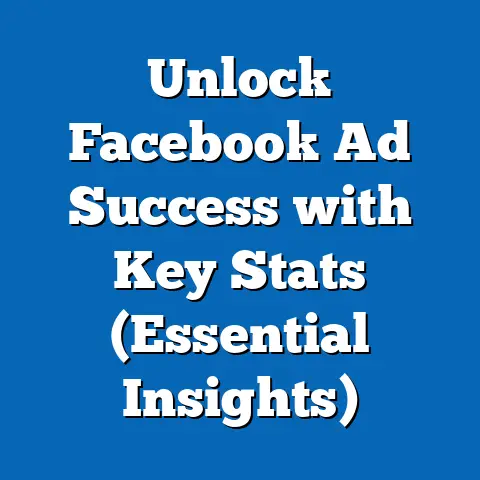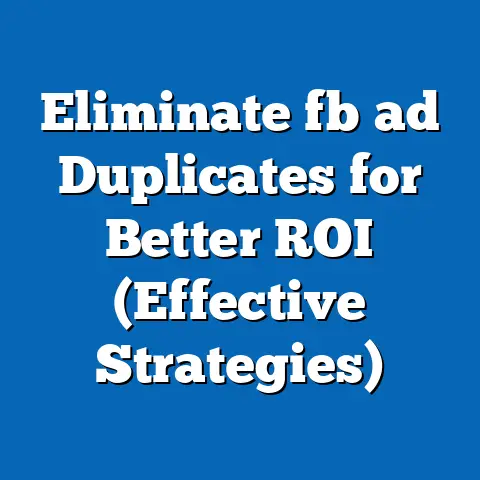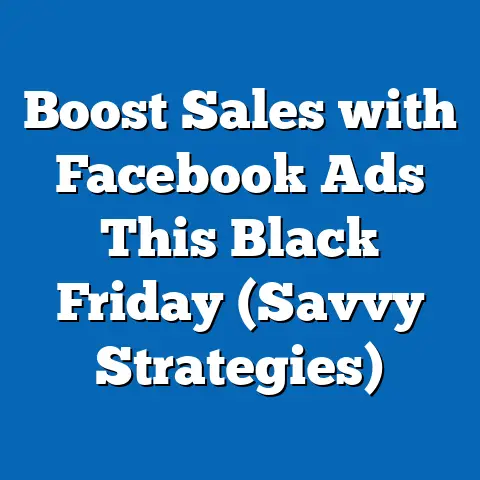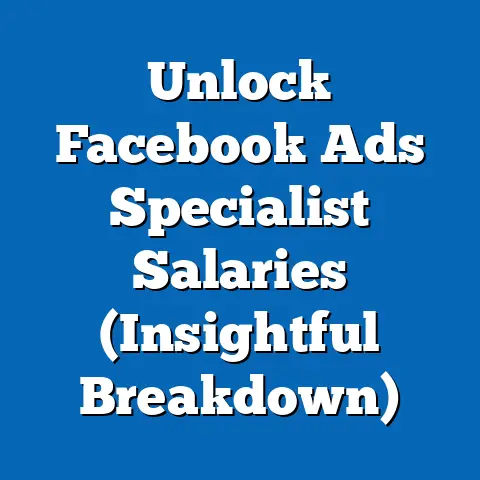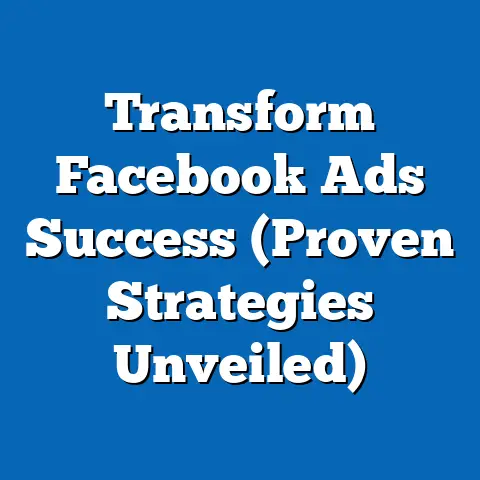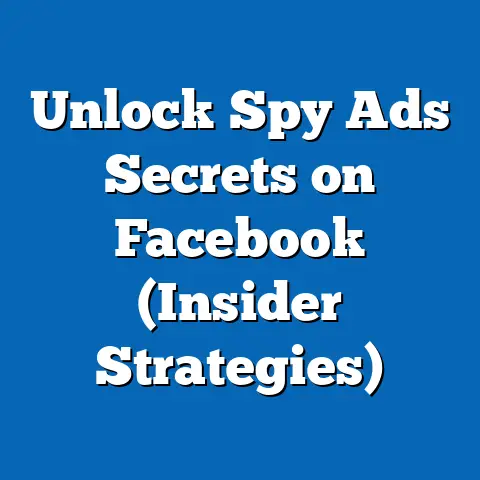Maximize ROI by Blending Google & Facebook Ads (Pro Insights)
The advertising landscape has drastically changed over the years. I remember when businesses primarily relied on print ads in newspapers, expensive television commercials, and radio spots. These traditional methods often felt like shouting into a void, hoping the right people would hear. The rise of the internet completely revolutionized marketing, giving us the power to target specific audiences with unprecedented precision.
1. Understanding Google Ads
1.1 Overview of Google Ads
Google Ads is Google’s online advertising platform, where you pay to display brief advertisements, service offerings, product listings, video content, and generate mobile app installs within the Google ad network to web users. This network includes Google Search, YouTube, and millions of partner websites. The platform operates on a pay-per-click (PPC) model, meaning you only pay when someone clicks on your ad.
Google Ads is structured around campaigns, ad groups, and individual ads. Campaigns are broad objectives, like generating leads or driving website traffic. Ad groups organize your ads around specific themes or keywords. And the ads themselves are the messages you present to your potential customers.
The platform offers a variety of campaign types, each designed for a specific purpose:
- Search Ads: Text-based ads that appear on Google’s search results pages.
- Display Ads: Visual ads that appear on websites, apps, and videos across the Google Display Network.
- Video Ads: Ads that run on YouTube and other video platforms.
- Shopping Ads: Product listings that appear on Google Shopping and search results pages.
- App Ads: Ads designed to promote your mobile app and drive installs.
Bidding strategies in Google Ads are crucial to controlling costs and maximizing ROI. You can choose from automated bidding options, like Target CPA (cost per acquisition) or Maximize Conversions, or manual bidding, where you set your own bids for individual keywords. The best strategy depends on your goals, budget, and campaign performance.
1.2 Benefits of Google Ads
One of the biggest advantages of Google Ads is its precise targeting capabilities. You can target users based on:
Another key benefit is the ability to track your results meticulously. Google Ads provides detailed data on impressions, clicks, conversions, and cost per conversion. This allows you to see exactly how your campaigns are performing and make data-driven adjustments to improve your ROI.
1.3 Case Studies of Successful Google Ads Campaigns
Let’s look at a couple of examples of businesses that have successfully leveraged Google Ads:
- Example 1: Local Plumber: A local plumbing company used Google Ads to target users searching for “emergency plumber near me.” By focusing on relevant keywords and geographic targeting, they were able to quickly connect with customers in need of immediate assistance. This resulted in a significant increase in service calls and revenue.
- Example 2: E-commerce Store: An online retailer selling handmade jewelry used Google Shopping Ads to showcase their products to a wider audience. By optimizing their product listings and using high-quality images, they were able to attract more clicks and drive sales. They also used retargeting to reach users who had previously visited their website but hadn’t made a purchase.
Takeaway: Google Ads is a powerful platform for reaching high-intent customers and driving measurable results. By understanding its structure, targeting capabilities, and bidding strategies, you can create effective campaigns that deliver a strong ROI.
2. Understanding Facebook Ads
2.1 Overview of Facebook Ads
Facebook Ads is the advertising platform for Facebook, Instagram, Messenger, and the Audience Network. It allows businesses to reach a massive audience with highly targeted ads. Like Google Ads, Facebook Ads operates on a bidding system, where you compete with other advertisers to show your ads to the right people.
The Facebook Ads Manager is the central hub for creating, managing, and tracking your campaigns. It provides a user-friendly interface for setting up your ads, defining your target audience, and monitoring your performance.
Facebook Ads offers a variety of ad formats, including:
- Image Ads: Single image ads that are simple and effective.
- Video Ads: Engaging video ads that capture attention.
- Carousel Ads: Showcase multiple products or features in a single ad.
- Slideshow Ads: Create a video-like experience with a series of images.
- Collection Ads: Display a catalog of products with a focus on visual appeal.
- Lead Ads: Collect leads directly from your ads without sending users to a landing page.
2.2 Benefits of Facebook Ads
Facebook Ads excels at reaching specific audiences based on detailed demographic, interest, and behavioral data. You can target users based on:
- Demographics: Age, gender, education, relationship status, and more.
- Interests: Hobbies, activities, pages they like, and topics they follow.
- Behaviors: Purchase history, device usage, travel habits, and other behaviors.
- Custom Audiences: Upload your own customer data to target existing customers or create lookalike audiences.
- Lookalike Audiences: Reach new people who are similar to your existing customers.
One of the biggest strengths of Facebook Ads is its ability to drive engagement and build brand awareness. The platform’s social nature encourages users to interact with your ads, share them with their friends, and leave comments.
Facebook Ads is also ideal for retargeting. You can show ads to people who have visited your website, watched your videos, or engaged with your content on Facebook. This helps you stay top-of-mind and encourage them to take the next step.
2.3 Case Studies of Successful Facebook Ads Campaigns
Here are a couple of examples of businesses that have successfully used Facebook Ads:
- Example 1: Fashion Boutique: A local fashion boutique used Facebook Ads to promote its new collection. By targeting users interested in fashion, style, and local shopping, they were able to drive significant traffic to their store. They also used retargeting to reach users who had viewed their products online but hadn’t made a purchase.
- Example 2: Online Course Provider: An online course provider used Facebook Ads to generate leads for its upcoming courses. By targeting users interested in specific topics and career paths, they were able to attract a large number of qualified leads. They used lead ads to make it easy for users to sign up for more information.
Takeaway: Facebook Ads is a powerful platform for reaching specific audiences, driving engagement, and building brand awareness. By understanding its targeting options, ad formats, and retargeting capabilities, you can create effective campaigns that deliver a strong ROI.
3. The Power of Blending Google & Facebook Ads
3.1 The Synergy Between Google and Facebook Ads
While Google Ads and Facebook Ads are both powerful platforms, they excel at different things. Google Ads is ideal for reaching users with high intent, while Facebook Ads is ideal for building brand awareness and driving engagement.
When you blend these two platforms, you create a synergistic effect that amplifies your results. You can use Google Ads to capture users who are actively searching for your products or services, and then use Facebook Ads to nurture those leads and build a relationship with them.
Think of it like this: Google Ads is the hunter, finding potential customers actively seeking solutions. Facebook Ads is the farmer, cultivating relationships and nurturing those prospects into loyal customers.
3.2 Audience Insights and Retargeting
One of the most powerful ways to blend Google and Facebook Ads is to use audience insights from one platform to optimize campaigns on the other. For example, you can use data from Facebook to identify the demographics, interests, and behaviors of your most valuable customers. You can then use this information to refine your targeting in Google Ads.
Retargeting is another key strategy for blending the two platforms. You can use Google Ads to retarget users who have visited your website but haven’t made a purchase. You can also use Facebook Ads to retarget users who have engaged with your content on Facebook.
For example, I once worked with a client who sold high-end skincare products. We used Google Ads to target users searching for specific skincare concerns, like “anti-aging cream” or “acne treatment.” We then used Facebook Ads to retarget those users with ads featuring testimonials and before-and-after photos. This combination of targeted search ads and engaging retargeting ads resulted in a significant increase in sales.
3.3 Integrated Campaign Strategies
Creating integrated campaigns that utilize both Google and Facebook Ads requires careful planning and coordination. Here are a few strategies to consider:
- Consistent Messaging: Ensure that your messaging is consistent across both platforms. Use the same branding, tone, and value proposition in your ads on Google and Facebook. This will create a cohesive brand experience for your potential customers.
- Budget Allocation: Determine the optimal budget split between Google and Facebook Ads based on your goals and audience behavior. If you’re focused on driving immediate sales, you may want to allocate more of your budget to Google Ads. If you’re focused on building brand awareness, you may want to allocate more of your budget to Facebook Ads.
- Track Performance: Use analytics tools to track your performance across both platforms. This will help you identify what’s working and what’s not, and make data-driven adjustments to improve your ROI.
Takeaway: Blending Google and Facebook Ads allows you to reach a wider audience, build brand awareness, and drive conversions. By using audience insights, retargeting, and integrated campaign strategies, you can unlock the full potential of these two powerful platforms.
4. Measuring and Analyzing ROI
4.1 Key Performance Indicators (KPIs)
To effectively measure the ROI of your Google and Facebook Ads campaigns, it’s essential to track the right Key Performance Indicators (KPIs). Here are some of the most important metrics to consider:
- Click-Through Rate (CTR): The percentage of people who see your ad and click on it. A high CTR indicates that your ad is relevant and engaging.
- Conversion Rate: The percentage of people who click on your ad and then complete a desired action, such as making a purchase or filling out a form. A high conversion rate indicates that your landing page is effective and your offer is compelling.
- Cost-Per-Click (CPC): The amount you pay each time someone clicks on your ad. A low CPC indicates that your keywords are relevant and your bidding strategy is effective.
- Cost-Per-Acquisition (CPA): The amount you pay to acquire a new customer. A low CPA indicates that your campaigns are efficient and your ROI is strong.
- Customer Lifetime Value (CLTV): The total revenue you expect to generate from a single customer over their entire relationship with your business. Understanding your CLTV can help you determine how much you’re willing to spend to acquire a new customer.
4.2 Tools for Measurement
Several tools can help you track and analyze your campaign performance across both Google and Facebook Ads:
- Google Analytics: A free web analytics service that provides detailed data on website traffic, user behavior, and conversion rates.
- Facebook Insights: A built-in analytics tool that provides data on your Facebook page’s performance, audience demographics, and engagement metrics.
- Google Ads Conversion Tracking: A feature that allows you to track conversions that result from your Google Ads campaigns.
- Facebook Pixel: A code snippet that you place on your website to track conversions, build custom audiences, and optimize your Facebook Ads campaigns.
- Third-Party Analytics Tools: Several third-party tools, such as HubSpot, SEMrush, and Ahrefs, can provide additional insights and reporting capabilities.
4.3 Interpreting Data for Better ROI
Interpreting data from both platforms is crucial for making informed decisions that maximize ROI. Here are a few examples of data-driven adjustments you can make:
- If your CTR is low: Try improving your ad copy, using more relevant keywords, or targeting a different audience.
- If your conversion rate is low: Try optimizing your landing page, improving your offer, or simplifying the checkout process.
- If your CPC is high: Try refining your keywords, improving your Quality Score, or adjusting your bidding strategy.
- If your CPA is high: Try optimizing your targeting, improving your ad relevance, or lowering your bids.
For instance, I once noticed that a client’s Facebook Ads campaign had a high CTR but a low conversion rate. After analyzing the data, I realized that the landing page was not optimized for mobile devices. By creating a mobile-friendly landing page, we were able to significantly improve the conversion rate and lower the CPA.
Takeaway: Measuring and analyzing your ROI is essential for optimizing your Google and Facebook Ads campaigns. By tracking the right KPIs, using the right tools, and interpreting the data effectively, you can make data-driven adjustments that improve your performance and maximize your ROI.
5. Advanced Strategies for Maximizing ROI
5.1 A/B Testing Across Platforms
A/B testing, also known as split testing, is a method of comparing two versions of an ad or landing page to see which one performs better. It’s a crucial strategy for optimizing your campaigns and maximizing ROI.
When A/B testing across Google and Facebook Ads, consider testing the following elements:
- Ad Copy: Test different headlines, descriptions, and calls to action.
- Images: Test different images and videos to see which ones resonate best with your audience.
- Landing Pages: Test different landing page layouts, designs, and offers.
- Targeting: Test different targeting options to see which audiences are most responsive.
For example, I once worked with a client who was running a Facebook Ads campaign to promote a new product. We created two versions of the ad, one featuring a product demo video and the other featuring a customer testimonial. After running the ads for a week, we found that the ad with the customer testimonial had a significantly higher conversion rate. We then switched all of our budget to the ad with the customer testimonial, which resulted in a significant increase in sales.
5.2 Budget Allocation Strategies
Determining the optimal budget split between Google and Facebook Ads depends on your business goals, audience behavior, and campaign performance. Here are a few strategies to consider:
- Equal Split: Allocate an equal amount of your budget to both platforms. This is a good starting point if you’re unsure which platform will perform better.
- Goal-Based Allocation: Allocate more of your budget to the platform that is most likely to help you achieve your goals. For example, if you’re focused on driving immediate sales, you may want to allocate more of your budget to Google Ads. If you’re focused on building brand awareness, you may want to allocate more of your budget to Facebook Ads.
- Performance-Based Allocation: Allocate more of your budget to the platform that is performing better. Continuously monitor your campaign performance and adjust your budget accordingly.
- Funnel-Based Allocation: Allocate your budget based on the stage of the marketing funnel. Use Google Ads to capture users at the top of the funnel (awareness stage) and Facebook Ads to nurture leads at the bottom of the funnel (conversion stage).
5.3 Leveraging Automation and AI
Automation and AI tools can significantly enhance campaign efficiency and effectiveness on both Google and Facebook Ads. Here are a few ways to leverage these technologies:
- Automated Bidding: Use automated bidding strategies, such as Target CPA or Maximize Conversions, to let Google and Facebook automatically adjust your bids based on real-time data.
- Dynamic Ads: Use dynamic ads to automatically generate ads based on your product catalog or website content.
- AI-Powered Targeting: Use AI-powered targeting options to reach new audiences that you may not have considered.
- Chatbots: Use chatbots to automate customer service and lead generation on Facebook Messenger.
I’ve seen firsthand how automation can transform campaign performance. For example, one of my clients, an e-commerce store, implemented dynamic ads on Facebook. The platform automatically generated ads showcasing their most popular products to users who had previously visited their website. This resulted in a 30% increase in sales and a significant reduction in the amount of time spent managing the campaign.
Takeaway: Advanced strategies like A/B testing, strategic budget allocation, and leveraging automation and AI can help you take your Google and Facebook Ads campaigns to the next level. By continuously testing, optimizing, and adapting to new technologies, you can maximize your ROI and achieve your business goals.
Conclusion
In today’s competitive digital landscape, maximizing ROI is paramount for any business looking to thrive. By strategically blending Google and Facebook Ads, you can create a powerful, integrated advertising strategy that reaches a wider audience, drives engagement, and generates conversions.
I’ve shared my insights and experiences to help you understand the synergy between these two platforms, create integrated campaigns, measure and analyze your ROI, and implement advanced strategies for maximizing your results.
The transformative potential of a well-integrated advertising strategy is undeniable. I encourage you to consider a holistic approach to your digital marketing efforts and explore the possibilities of blending Google and Facebook Ads.
Ready to take your advertising to the next level? Start implementing the strategies discussed in this guide and watch your ROI soar. Don’t just take my word for it; test, analyze, and optimize your campaigns to discover what works best for your business. The results may surprise you.

